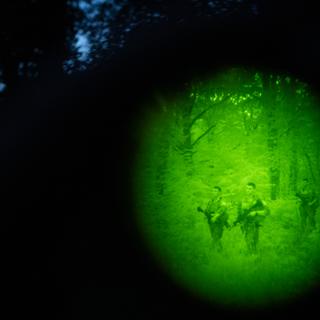


Combat divers and surveillance drones: How the French army secured the Olympics
In DepthIn total 10,000 military personnel participated in providing security for the Games. According to General Christophe Abad, the military governor of Paris, this unprecedented mission was handled like a 'real military operation.'
Thursday, July 8, 9:30 pm: It was the first patrol of the night for the soldiers providing security at the Guyancourt national golf course, where the Olympic golf events would be held until August 10. At the request of Paris police prefect Laurent Nuñez, Colonel Vincent Flore, the commander of the 4th Chasseurs Regiment (stationed in Gap, in the southeast of France), had taken charge of nighttime security at the national golf course, as well as at the Elancourt hill, the national velodrome and the BMX stadium in Montigny-le-Bretonneux.
"We're facing a terrorism risk, but we're also taking into account the threat of protests, particularly at the national golf course," said Flore, in his temporary quarters at the Satory camp in Versailles. In July 2023, environmental activists took advantage of the nocturnal darkness to vandalize the Vieille-Toulouse golf course (southwestern France), denouncing the consumption of water for "luxury, non-essential activities." The Guyancourt course, with its 8-kilometer perimeter and vast adjacent rural environment, is seen by the military as being particularly vulnerable to intrusion.
For this reason, an outpost was set up on a large private parking lot directly adjacent to the golf course. On the asphalt, a line of five quad bikes started moving. "We're setting up multi-sensor patrols, adapted to wooded areas and large expanses of fields, through which we will advance in the middle of the night. This allows us to get off the main roads and go off-road, so that we can quickly cover a large area," explained Captain Florent, who oversees the operation.

At the edge of the woods, shrouded in the darkness of dusk, the quad bikes came across a foot patrol. The drivers were equipped with night-vision goggles as well as another asset: Rispy, a 5-year-old Belgian Malinois. "In the case of the protest threat, we're obviously not there to neutralize," insisted Colonel Flore, who summarized his soldiers' stance in a two-part phrase: "Dissuasive for the adversary, reassuring for the population."
'A much broader spectrum of missions'
After crisscrossing the forest, the quad bikes entered the fields, raising a thick cloud of dust. When night fell, five pairs of headlights turned toward a point of light that floated some 40 meters above the ground. Below it was a small group gathered around a drone operator. Sitting in a camping chair, Brigadier Owon of the 61st Artillery Regiment had his eyes fixed on a tablet resting on his lap. It controlled the point of light, an NX70 drone tethered to a ground battery.
You have 55.92% of this article left to read. The rest is for subscribers only.
